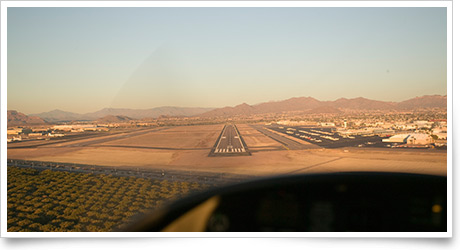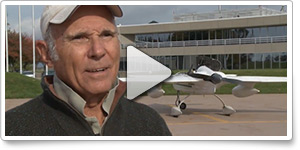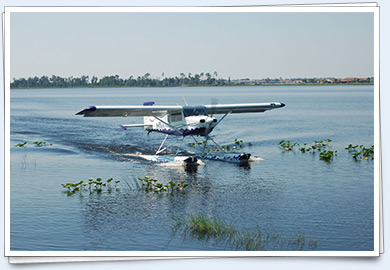Nov. 02, 2012, issue of 'AOPA ePilot: Flight Training Edition' weekly newsletter
| ||||||
| Avoiding ‘red over red’ |
| |||||
Training TipsAvoiding ‘red over red’
Thinking it over later, it wasn’t difficult to identify some clues that could have headed off trouble. One was the wind. It was blowing strongly down the runway, which meant high groundspeed on the downwind leg, but unusually low groundspeed on final. Perhaps the trainee should have adjusted for that by turning base a bit closer in than on a calm day (or by reducing power more gradually, starting with the base turn).
Breaking the rote habit pattern might have helped the student recognize that the trainer was getting too low on final. Do you have a sight picture for judging whether your descent to the runway is proceeding at a correct rate? Many students are taught that if the runway appears to be moving up in the windscreen, you are getting too low. If the runway seems to be slipping away under the nose, you are too high. A stationary runway means a correct glide.
The student pilot noted that the satellite airport being used for practice lacked a visual approach slope indicator (VASI) or other form of vertical guidance. Perhaps he had become too dependent on the home airport’s VASIs.
The approach also illustrated how you can get into trouble by allowing the aircraft to be flown on the “back side of the power curve”—a high-drag condition that can result from the pilot’s adding back-pressure—instead of power—to control the descent. (That situation was starting to develop at the end of the approach just flown.)
The student recalled a session of dual instruction in slow flight: He and his flight instructor had jotted down the airspeeds flown and the associated power settings. Later they created a graph of the power curve for the trainer, which identified the airspeed below which induced drag began to exert its most pronounced effects.
The student also realized that a timely go-around was the remedy once it was obvious that the approach was turning into one of those “red over red” affairs so easy to recognize using the VASI back at the home airport. Flight Training NewsStallion 51 offers unusual attitude trainingStallion 51, long the place to go if you want to fly a North American P-51 Mustang, now offers unusual attitude training to the corporate world and other interested pilots. The Kissimmee, Fla., company uses a specially equipped Aero Vodochody L-39 jet trainer. Read more >> Irving launching world education flightBarrington Irving will launch a classroom in the sky in October 2013, spending five months inspiring and teaching seven million school children in grades three to 10 during a flight around the world. He will use a Hawker 400XPR jet provided by Hawker Beechcraft, and has 13 companies as sponsors. Read more >> November’s Flight Training chat focuses on aircraft maintenanceWhat should you know about aircraft maintenance? If you’re a renter pilot, you might shrug and think, “Nothing. The school handles that”—but you might be surprised at what you should know. Talk about all things related to aircraft maintenance at the November Flight Training Facebook chat. Our guest will be AOPA Senior Aviation Technical Specialist Craig Brown, who holds an airframe and powerplant certificate. Join us at 3 p.m. Eastern on Nov. 6. Log on to the Flight Training Facebook page to set an email reminder or view transcripts of previous chats. Alliance brings STEM education to deaf learnersThe advancement of science, technology, engineering, and mathematics (STEM) education at dedicated schools for deaf students, and in mainstream programs for deaf and partially deaf learners, is the goal of a joint project of Fly To Learn and the Deaf Pilots Association. Beta testing of curricula developed for the program will begin in three middle- or high-school age classrooms in schools for deaf students in 2013, with nationwide implementation to follow. Read more >> Training ResourcesAn aircraft’s carburetor has a simple task: taking fuel and air and placing them into a combustible mixture for the engine. But it is not a perfect system. With the right set of variables, its function can be affected significantly. Learn about these conditions, and how to prevent and remedy this form of induction icing, by reading the Air Safety Institute’s Combating Carb Ice Safety Brief.
Did you know that student pilots who join AOPA are three times more likely to complete their flight training? Membership includes unlimited access to aviation information by phone (800/USA-AOPA, weekdays from 8:30 a.m. to 6 p.m. Eastern time) or from Flight Training Online or AOPA Online. If you’re not already a member, join today and get the pilot’s edge. Login information is available online. Meet astronaut Mike Melvill Career PilotAmerican to hire more than 1,500 flight attendantsAmerican Airlines announced Oct. 17 that in early November it will begin the process of recruiting and hiring more than 1,500 new flight attendants, with the first new-hire class beginning training in January 2013. The overwhelming response by current flight attendants to the company’s recent voluntary separation options, combined with an aggressive training schedule during the transition to the newly established flight attendant contract, led to the decision. The airline will post the job openings in November, at which time eligible candidates can apply online. American intends to start the selection process for new-hire flight attendant candidates in early December. Atlas Air, Polar Air Cargo dispatchers reach tentative agreementNegotiators for the flight dispatchers at Atlas Air and Polar Air Cargo, represented by the Airline Division of the International Brotherhood of Teamsters, announced Oct. 19 that a tentative agreement has been reached on a first contract for the members. The FAA-licensed flight dispatchers, members of Local 210, are responsible for coordination with aircraft flight crews to ensure the safe dispatch and operation of flights around the world for Atlas Air Inc. and Polar Air Cargo, the world’s largest all-Boeing 747 cargo airline. The companies conduct cargo operations for many airlines and provide important airlift of cargo and troops for the U.S. military. The tentative agreement includes extensive economic improvements as well as multiple positive work rule changes. A vote on the agreement has not yet been scheduled, but is expected soon. Plane SpotterCessna 162: The missing link Training ProductsNFlightCam strut/bar mountMore pilots are videotaping their flights to preserve memories as well as learn from the footage. If you use an NFlightCam for that purpose, this mount from Sporty’s is designed to attach the camera to round surfaces up to 3 inches in diameter. Its double-socket arm and ball design allows you to adjust the camera position in a variety of angles. The mount sells for $49.99 and will ship on Nov. 15. Order online or call 800/776-7897.
Note: Products listed have not been evaluated by ePilot editors unless otherwise noted. AOPA assumes no responsibility for products or services listed or for claims or actions by manufacturers or vendors. Member BenefitsStarting a flying club: Find out howFlying clubs offer lower costs, camaraderie, quality instruction, and a viable business model to pilots around the world. If you’re thinking of starting one in your neck of the woods, join AOPA for a webinar Nov. 14 at 8 p.m. Eastern time to find out what’s involved. The webinar panel will include counsel on legal and entity concerns as they apply to clubs. We’ll also hear from the director of a successful new flying club as he shares his experiences in the first of several webinars on various flying club topics. Space is limited. Reserve your seat now >> Diabetes mellitus on oral medicationsDiet-controlled diabetes mellitus is one of the five medical conditions that your aviation medical examiner may grant issuance if you come to your examination with the proper documentation. Diabetes mellitus treated with oral medications or insulin is one of the FAA’s specifically disqualifying medical conditions. This means that if you have one of these problems, your AME may not issue you a medical certificate without going through requesting a special issuance from the FAA. Read more from Dr. Warren Silberman >> How strong is your safety net?Whether you are flying, driving, or on a hike in the park, AOPA can help protect all that is important to you. As AOPA previously announced, the new AOPA Accidental Death and Dismemberment Group Insurance Plan has been expanded beyond the cockpit to provide you 24/7 coverage without any increase in cost. BlogsPete’s solo storyThe Flight Training blog offers a first solo story like many others you might have read, but Pete Nardo adds a few thought-provoking insights and offers perspective for post-solo pilots, too. October 4, 2012: Smart enough to fly?If you have a knowledge test in your future, you’ll want to read Blaine Transue’s tips for preparation and study in the Let's Go Flying blog. AOPA Career OpportunitiesEver dream of turning your passion for aviation into a career? We’re looking for a member services representative; manager, AOPA Flying Club Network; marketing production specialist; contract administrator; accounts receivable payable tech; Web developer (eMedia); major gifts officer; and Web graphic designer. To learn more about other AOPA career opportunities, visit AOPA Online. Community
AVIATION EVENTS & WEATHER
| ||||||||||||||||||||||||||||||||||||




 The trainer struggled to the runway threshold, barely making the pavement with high power and stall horn blaring. The student pilot was perplexed by the
The trainer struggled to the runway threshold, barely making the pavement with high power and stall horn blaring. The student pilot was perplexed by the 




